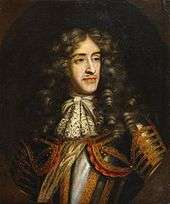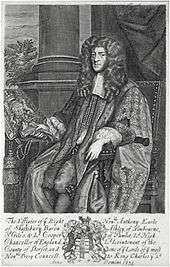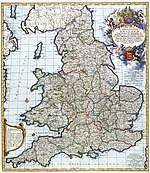Exclusion Crisis
The Exclusion Crisis ran from 1679 through 1681 in the reign of King Charles II of England, Scotland and Ireland. Three Exclusion bills sought to exclude the King's brother and heir presumptive, James, Duke of York, from the thrones of England, Scotland and Ireland because he was Roman Catholic. None became law. Two new parties formed. The Tories were opposed to this exclusion while the "Country Party", who were soon to be called the Whigs, supported it. While the matter of James's exclusion was not decided in Parliament during Charles's reign, it would come to a head only three years after he took the throne, when he was deposed in the Glorious Revolution of 1688. Finally, the Act of Settlement 1701 decided definitively that Catholics were to be excluded from the English throne.
Background

In 1673, when he refused to take the oath prescribed by the new Test Act, it became publicly known that the Duke of York was a Roman Catholic. His secretary, Edward Colman, had been named by Titus Oates during the Popish Plot (1678) as a conspirator to subvert the kingdom. Members of the Anglican English establishment could see that in France a Catholic king was ruling in an absolutist way, and a movement gathered strength to avoid such a form of monarchy from developing in England, as many feared it would if James were to succeed his brother Charles, who had no legitimate children. Sir Henry Capel summarised the general feeling of the country when he said in a parliamentary debate in the House of Commons of England on 27 April 1679:
From popery came the notion of a standing army and arbitrary power... Formerly the crown of Spain, and now France, supports this root of popery amongst us; but lay popery flat, and there's an end of arbitrary government and power. It is a mere chimera, or notion, without popery.[1]
Crises
The occasion which brought these sentiments to a head was the impeachment of Thomas Osborne, Earl of Danby, as a scapegoat for a scandal by which Louis XIV bought the neutrality of Charles's government with an outright bribe. Charles dissolved the Cavalier Parliament, but the new Parliament which assembled on 6 March 1679 was even more hostile to the king and to his unfortunate minister, thus Danby was committed to the Tower of London.

On 15 May 1679, the supporters of Anthony Ashley Cooper, 1st Earl of Shaftesbury, introduced the Exclusion bill in the Commons with the intention of excluding James from the succession to the throne. A fringe group there began to support the claim to the throne of Charles's illegitimate – but Protestant – son, the Duke of Monmouth. As it seemed likely that the bill would pass in the House of Commons, Charles exercised his royal prerogative to dissolve Parliament again. Successive Parliaments attempted to pass such a bill, and were likewise dissolved.
End of the Crisis
While it should be treated with caution, the Exclusion Crisis is often identified as the point at which discernible political parties first emerged in England. Those who supported petitions asking Charles to recall Parliament and complete the passage of the Exclusion Bill were known as 'Petitioners' and later became Whigs. Those who opposed the Bill or so-called Abhorrers developed into the Tories.
The nature of politics in this period is illustrated by the fact that Shaftesbury, who opposed James due to his similarities to the absolutist Catholic French regime, was supported financially by Louis XIV of France who saw benefit in deepening English internal divisions.[2] The Popish Plot was used by the Whigs to mobilise support but moderates grew increasingly concerned by the hysteria it generated which caused the execution of 22 'conspirators' and accused the Queen of conspiring to poison her husband.[3] Many of Shaftesbury's supporters like the Earl of Huntingdon now switched sides and after two failed attempts to pass the Bill, Charles succeeded in labelling the Whigs as subversives. Louis now switched financial support to Charles, allowing him to dissolve the 1681 Oxford Parliament. It was not called again during his reign, depriving the Whigs of their main source of political support, i.e., government patronage; the failed 1683 Rye House Plot then completed their isolation.
One long-lasting result of the crisis was the codification of the writ of Habeas Corpus: the one concrete achievement of the short-lived Habeas Corpus Parliament of 1679 before it was dissolved. In passing this act, the Whig leaders were concerned for their own persons, apprehensive (correctly) that the King would try to move against them through the courts. But the act far outlived the specific crisis, having long-term implications for the British legal system (and later, the American one).
In fiction
Robert Neill's 1972 historical novel The Golden Days depicts the Exclusion Crisis as experienced by two Members of Parliament representing a rural constituency. Sir Harry Burnaby is a staunch Royalist who had been knighted for having helped Charles II's Restoration; his neighbor and fellow MP is Richard Gibson, an ex-Colonel in Oliver Cromwell's New Model Army, and an outspoken member of the Green Ribbon Club and of the emerging Whig party. Despite their sharp political differences, Burnaby and Gibson come to deeply respect each other, and they share the anxiety lest the unfolding crisis escalate beyond control and England be plunged again into all-out civil war. Eventually, Burnaby's son marries Gibson's daughter, with the full blessing of both fathers.
See also
- Religion in the United Kingdom
- British monarchy
- Popery
- Popish Plot
Notes
- Kenyon, John (2000). The Popish Plot. Phoenix Press. pp. 2–3.
- Corp, Edward (2009). A Court in Exile: The Stuarts in France, 1689–1718. Cambridge University Press. p. 12. ISBN 978-0521108379.
- Tapsell, Peter (2007). The Personal Rule of Charles II, 1681–85: Politics and Religion in an Age of Absolutism. Boydell Press. p. 90. ISBN 978-1843833055.
Further reading
- Edie, Carolyn (1965). "Succession and Monarchy: The Controversy of 1679–1681". American Historical Review. 70 (2): 350–370. JSTOR 1845634.
- Furley, O. W. (1957). "The Whig Exclusionists: Pamphlet Literature in the Exclusion Campaign, 1679–1681". Cambridge Historical Journal. 13: 19–36.
- Jones, J. R. (1961). The First Whigs: The Politics of the Exclusion Crisis, 1678–1683.
- Petrakos, Chris (2015). "'Those Times Can Tell The Story': The Anglican Reformation, Henry VIII's Succession Statutes, and England's Exclusion Crisis, 1679–1681". Anglican and Episcopal History. 84 (4): 393–415. JSTOR 43685165.
- Ronalds, Francis S. (1937). The Attempted Whig Revolution of 1678–81. University of Illinois Press.

.jpg)